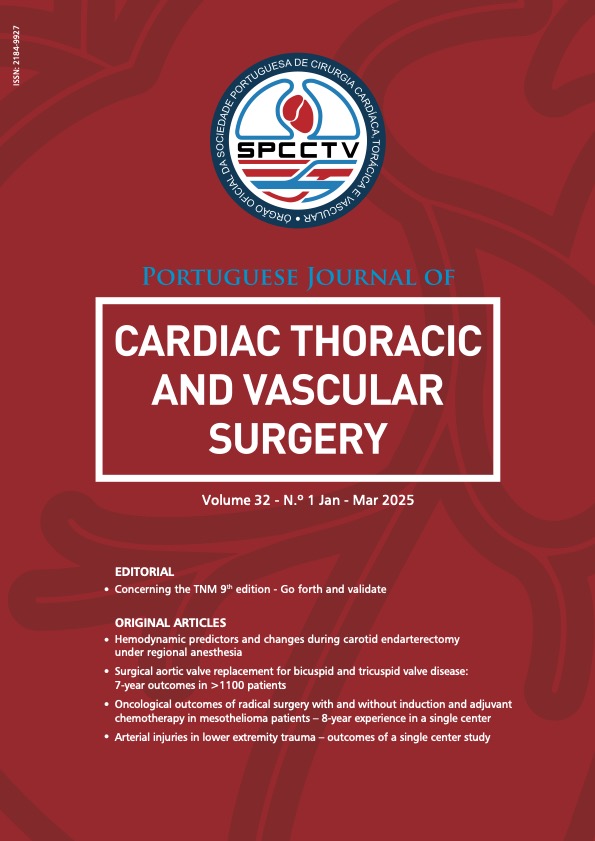Heparin Induced Thrombocytopenia In The Setting Of Urgent Cardiac Surgery: Can Bivalirudin Be A Safe Option? – A Case Report
DOI:
https://doi.org/10.48729/pjctvs.448Keywords:
bivalirudin, heparin, thrombocytopenia, cardiac surgical procedureAbstract
Unfractionated heparin is the main anticoagulant employed in the context of cardiovascular surgery. When a patient with heparin induced thrombocytopenia (HIT) is proposed for cardiac surgery, the anticoagulation management is challenging. Bivalirudin is an alternative to heparin in the perioperative setting. We present a rare case of a patient with HIT and cardiogenic shock that required bivalirudin use in the perioperative period of an urgent reoperation of recurrent mitral valve dysfunction. Although infrequent, the use of bivalirudin can be safe in high risk patients if adequate measures follow institutional protocols, as reported in this case.Downloads
References
Erdoes G, Ortmann E, Martinez B, Reid C, Koster A. Role of bivalirudin for anticoagulation in adult perioperative cardiothoracic practice. J Cardiothorac Vasc Anesth. 2020, 34(8):2207-2214. 10.1053/j.jvca.2019.08.022
Pishko AM, Cuker A. Heparin-induced thrombocytopenia in cardiac surgery patients. Semin Thromb Hemost. 2017, 43:691-698. 10.1055/s-0037-1602664
Koster A, Faraoni D, Levy JH. Argatroban and bivalirudin for perioperative anticoagulation in cardiac surgery. Anesthesiology. 2018, 128:390-400. 10.1097/ALN.000000000001976
Shorelesserson L, Baker RA, Ferraris VA, Greilich PE, Fitzgerald D et al. The society of thoracic surgeons, the society of cardiovascular anesthesiologists, and the american society of extracorporeal technology: clinical practice guidelines-anticoagulation during cardiopulmonary bypass. Ann Thorac Surg. 2018, 105:650-662. 10.1016/j.athoracsur.2017.09.061
Dyke CM, Smedira NG, Koster A, Aronson S, McCarthy HL Znd et al. A comparison of bivalirudin to heparin with protamine reversal in patients undergoing cardiac surgery with cardiopulmonary bypass: the EVOLUTION-ON study. J Thorac Cardiovasc Surg. 2006, 131(3):533-9. 10.1016/j.jtcvs.2005.09.057.
Koster A, Dyke CM, Aldea G, Smedira NG, McCarthy HL et al. Bivalirudin during cardiopulmonary bypass in patients with previous or acute heparin-induced thrombocytopenia and heparin antibodies: results of the CHOOSE-ON trial. Ann Thorac Surg. 2007, 83:572-7. 10.1016/j.athoracsur.2006.09.038
Sanfilippo F, Asmussen S, Maybauer DM, Santonotcio C, Fraser JF et al. Bivalirudin for alternative anticoagulation in extracorporeal membrane oxygenation: a systematic review. J Intensive Care Med. 2017, 32:312-319. 10.1177/0885066616656333
Wong JK, Tian Y, Shuttleworth P, Caffarelli AD, Reitz BA et al. Case report: a thrombus in the venous reservoir while using bivalirudin in a patient with heparin-induced thrombocytopenia undergoing heart transplantation. Anesth Analg. 2010,111:609-12. 10.1213/ANE.0b013e3181e9ead3
Awad H, Bryant R, Malik O, Dimitrovs G, Sai-Sudhakar CB et al. Thrombosis during off pump LVAD placement in a patient with heparin induced thrombocytopenia using bivalirudin. J Cardiothorac Surg. 2013, 8:115. 10.1186/1749-8090-8-115
Hassen K, Maccaroni MR, Sabry H, Mukherjee S, Serumadar S et al. Management of refractory bleeding post-cardiopulmonary bypass in an acute heparin-induced thrombocytopenia type II renal failure patient who underwent urgent cardiac surgery with bivalirudin (Angiox®) anticoagulation. Perfusion. 2018, 33:235-240. 10.1177/0267659117723457
Cartwright B, Mundell N. Anticoagulation for cardiopulmonary bypass, Part 2: alternatives and pathological states. BJA Educ. 2023, 23:256-263. 10.1016/j.bjae.2023.03.008
Downloads
Published
How to Cite
License
Copyright (c) 2025 Portuguese Journal of Cardiac Thoracic and Vascular Surgery

This work is licensed under a Creative Commons Attribution 4.0 International License.





